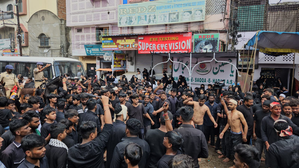Hyderabad: Solemnity and mourning marked ‘Yaum-e-Ashura’ on Wednesday as the historic ‘Bibi ka Alam” procession was taken out in the old city of Hyderabad in a traditional manner.
Thousands of people participated in the ‘Bibi ka Alam’ procession which passed through various parts of the old city before concluding at Chaderghat on the banks of the Musi river.
‘Yaum-e-Ashura’ or the 10th day of Muharram, the first month of the Islamic calendar, is observed in memory of the martyrdom of Prophet Mohammed’s grandson Imam Hussain and his followers at the battle of Karbala.
The ‘Bibi ka Alam’, believed to contain a piece of wooden plank on which the Prophet’s daughter Bibi Fatima Zehra was given the final ablution and installed over 430 years ago during the Qutub Shahi dynasty, was carried on a caparisoned elephant, brought from Karnataka. It started from Bibi Ka Alawa and passed through Sheikh Faiz Kaman, Yakutpura Darwaza, Etebar Chowk, Charminar, Gulzar Houz, Penjeshah, Mani Mir Alam, Purani Haveli and Darulshifa.
A total of 25 groups of self-flagellating mourners were leading the procession, which started from Bibi ka Alawa in Dabeerpura. Blood oozed out from the heads and chests of bare-chested Shia mourners who flagellated themselves with sharp-edged objects.
Amid cries of ‘Ya Hussain’ and recitation of ‘marsiya’ (elegies) and ‘noha-khwani’ (poems expressing sorrow), barefoot youths using knives, blade-encrusted chains and other sharp-edged weapons, inflicted injuries on themselves to show solidarity with the sufferings of the martyrs. Others were seen crying and beating their chests.
Police made elaborate security arrangements for the procession. Traffic was diverted at a few points for the annual procession.
Chief Secretary Santhi Kumari, Hyderabad Police Commissioner K. Sreenivas Reddy, other police officials, leaders of different political parties and family members of Nizam, ruler of erstwhile Hyderabad State, offered ‘dhattis’ en route. Santhi Kumari personally supervised the arrangements made for the peaceful and smooth conduct of the procession. She congratulated the police for making perfect arrangements.
“It was my lifetime experience,” she said on offering ‘Dhatti’.
Nawab Mir Muhammad Azmet Ali Khan, the ninth titular Nizam of Hyderabad, and other family members offered ‘Dhatti’ at Purani Haveli.
The ‘alam’ was carried on a female elephant named ‘Rupavati’, which was brought from Karnataka. The transport of the jumbo, belonging to Shri Jagadguru Panchacharya Mandir Trust in Davangere, was delayed due to certain issues with the Central government tweaking rules for inter-state transportation of captive elephants. Telangana’s Forest Minister Konda Surekha had intervened and spoke to her Karnataka counterpart Eshwar Khandre.
The Muharram procession dates back to the regime of Qutub Shahi King Abdullah more than 400 years ago. It is said Abdullah’s mother Hayat Bakshi Begum had initiated the annual procession. Camels, horses and elephants were used for the procession during the Qutub Shahi period.
The Sunni Muslims observed the day by fasting and holding meetings to remember the sacrifices of Imam Hussain and his followers who were martyred in 61 Hijri or 681 CE at Karbala in present-day Iraq. The fasting is observed on two days – ninth and 10th or 10th and 11th Muharram.
The day was also observed in various parts of Telangana in a traditional manner. Hindus also joined the processions in towns and villages.
–IANS


Comments are closed.